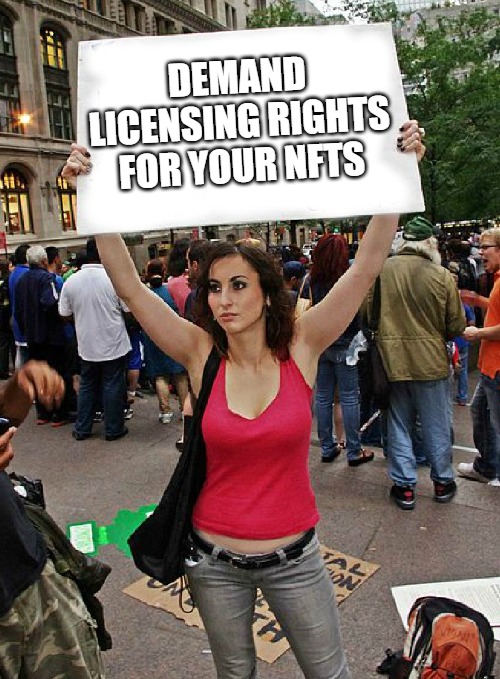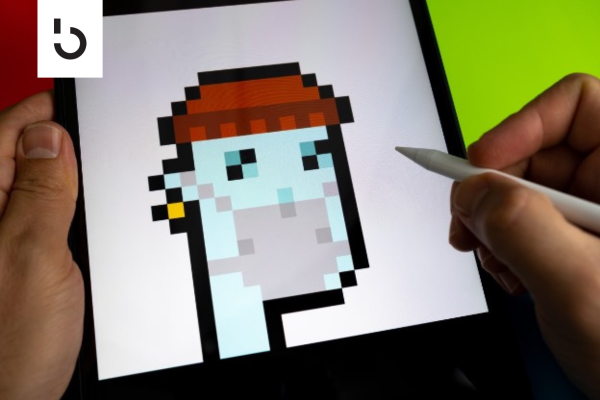
Investor Takeaways:
- Investing in NFTs today is like investing in collectibles (e.g., baseball cards or fine wines). Only invest if you really love NFTs and are willing to put in 10,000 hours to learn the market value of these unique, hard-to-price assets.
- As intelligent crypto investors, we look for underlying value. Most NFTs today have very little underlying value.
- But NFTs as a technology have a ton of potential value, especially if they are linked to underlying intellectual property (like earning future royalties on a pop song NFT).
- The best long-term investment is likely buying and holding tokens in NFT platforms — don’t buy a collectible, buy the collectible company.
NFTs are Digital Collectibles
I have a friend who loves collecting baseball cards.
David has been collecting since he was a kid, and he’s now in his forties. He lives near Fenway Park, and has season tickets to the Red Sox. After most games, he goes over to the official Red Sox store to check out the current cards for sale, noting their prices and how quickly they sell.
Then he goes online and looks for the same cards via online marketplaces, scooping up good bargains. He tends to buy and hold for the long term, selling when the price is right.
One of his greatest trades was paying $700 for a 1910 Beals Becker, then selling it for $2,700 a few years later.
David has thousands of hours of baseball card knowledge, which gives him a mighty edge when it comes to appraising the value of cards. He intuitively knows when he sees a good bargain, because he’s seen so many cards.
If you want to successfully invest in NFTs, approach them like my friend David does baseball cards. Think of NFTs as digital collectibles.
Intelligent crypto investors need some principles for investing in digital collectibles, also known as non-fungible tokens (NFTs). In this guide, I’ll briefly explain whether and why NFTs are worth anything, and where they might fit in your investment portfolio.
What Was the First NFT?
The first NFTs were a project called CryptoKitties (we literally wrote the book on it). These were digital cats that you could buy, sell, and breed with each other, with proof of ownership stored on the Ethereum blockchain.
When they were introduced in 2017, CryptoKitties were such a phenomenon that they brought down the entire Ethereum network. I remember going to Meetups where blockchain geeks were livid that these silly cartoon cats were disrupting their Very Important Business.
Great art is disruptive. We forget that the masters – from van Gogh to Picasso, from Wagner to Kanye West – redefined what art “should be.” Great artists break the molds.
…But is this art?
Now millions of people are “investing” in these NFTs, just as quickly as creators can churn them out. It’s not limited to cat memes: you can buy all kinds of digital art, pop music, sports memorabilia, and even virtual real estate.
Even if you understand all this, investing in NFTs may be a bit of a head-scratcher. For intelligent crypto investors, it brings us to the basic question: What are you really buying?
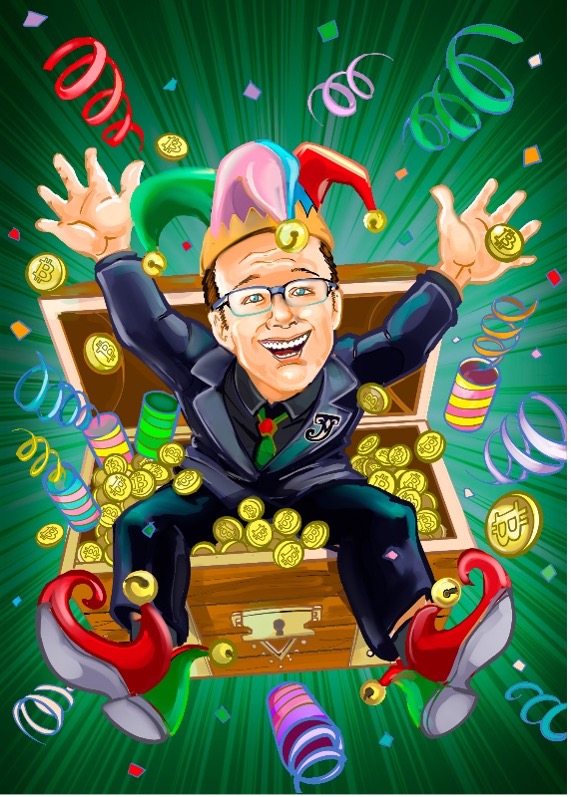
How Much is My NFT Worth?
NFTs are just a new form of collectibles, which have been around for as long as humans have been collecting stuff.
Traditional collectibles include not just fine art, but luxury items like wines and classic cars—as well as more common collectibles like coins and comic books.
Investing in collectibles relies on one central idea: that someone will pay more in the future for them.
The hard part is knowing which collectibles will be worth more in the future. It’s easy to see the mint-edition Superman comic is valuable now ($3.2 million), but it wasn’t easy to see then, or more people would have saved them. With collectibles, scarcity drives the price.
The argument for NFTs is that they are scarce by definition: if you’re buying Jack Dorsey’s first tweet, well, there’s only one of them. You become the owner, with the digital record verified on a public blockchain.
…But is this true?
Does anyone really own Jack Dorsey’s first tweet? Seeing a photo of the Mona Lisa is not the same as seeing the actual Mona Lisa, but seeing a link to Dorsey’s first tweet is exactly the same as seeing the “original.” Why on earth would someone pay $2.5 million for that?
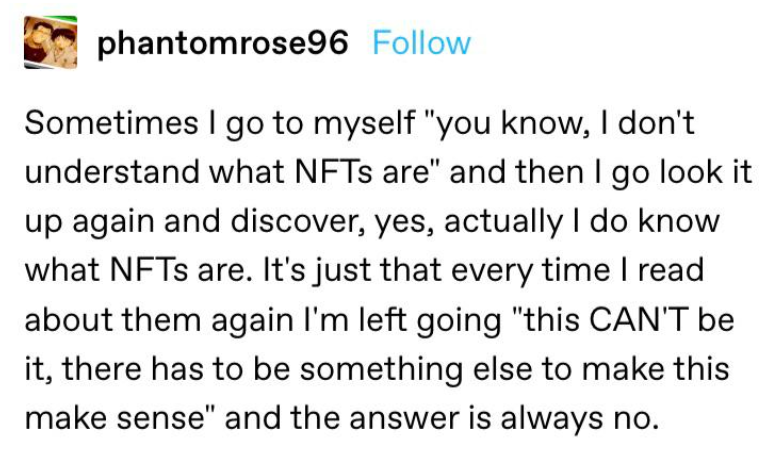
The New York Times art critic Jason Farago dismissed the concept of NFTs. I want to be careful about writing off the entire movement — because great art is disruptive. (I suspect Farago’s NFT column will age like a banana duct-taped to a wall.)
There’s a huge difference between enjoying or appreciating art, and investing in art. When you buy an NFT, you are entering the world of investing—why else would you buy it? A perfect digital replica is already available, for free. (Just take a screenshot.)
Today, buying NFTs is buying bragging rights. If you think the bragging rights will be worth more in the future – and they may be! – then invest in them. But realize that collectibles are a highly risky and highly illiquid investment, and NFTs even more so. Here’s why.
What Makes an NFT Valuable?
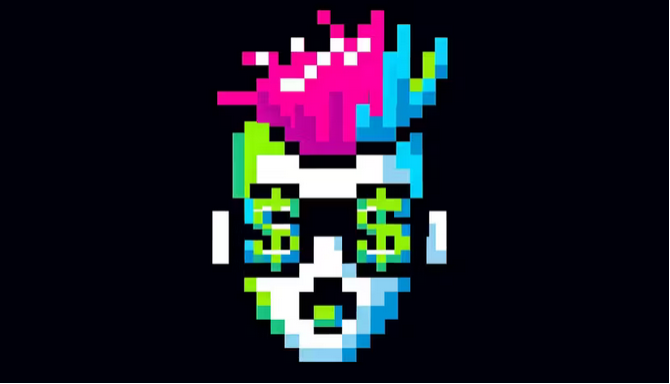
As I write this, Cryptopunk 635 (pictured here) was just purchased for 4,000 ETH: about $12 million.
I’m not sure I would put this on the level of a Monet or Rembrandt, but NFT collectors are really just interested in whether someone will pay more for it in the future.
This requires expertise: you have to evaluate a lot of NFTs before you can feel confident in your assessment. You don’t just go to OpenSea and sort by “Greatness.”
Here are some other factors that professional NFT collectors look for:
- Scarcity: Cryptopunks was one of the first NFT collections ever created. Generated by a computer algorithm, this particular punk is classified as an “Alien,” a highly sought-after attribute, as there are only 0.1% of Alien Punks in the 10,000-piece collection. It’s got double scarcity: it’s a rare item in a rare collection.
- The Artist: If they’re already a celebrity, the NFT may hold its value (provided the market doesn’t crash). The digital artist Pak holds the record for the most expensive NFT collection, entitled The Merge, which sold for a total of $91.8 million in 2021. Pak’s future work is probably a safe bet.
- Level of Effort: A one-of-a-kind painting, film, or song that takes many hundreds of hours to produce will likely retain its value more than slight variations on a Photoshop template. Beeple’s EVERYDAYS is the most expensive single NFT, at $69 million. Future Beeple NFTs are probably a safe bet.
- History of Ownership: Since it’s all transparent on the blockchain, a history of owners, with each paying progressively higher prices, is more likely to lead to higher prices in the future (if the market holds). CryptoKitties, for example, generally have a long history of owners, making them better bets (especially if the price history is going up).
- Royalties and Licensing Rights: NFT owners can receive royalties and/or licensing rights from the underlying intellectual property. For example, Eminem and Snoop purchased Bored Ape NFTs then used them in a music video, thus increasing their value.
If modern art is tricky to value, NFTs are even trickier—especially given that art is only one of the NFT categories. Here are three possible investing strategies for intelligent crypto investors.
NFT Investing Strategy #1: Treat Them Like Collectibles
For most crypto investors, NFTs are not a reliable way to make money. It’s like collecting vintage wines or Pokemon cards: only invest in NFTs if you love them, and are willing to spend years to become an expert. If you go this route:
Keep them a small slice of your portfolio. Traditional financial advisors recommend no more than 5% of your portfolio be invested in collectibles, if you’re rich. For the rest of us, keep NFTs as less than 1% of your Blockchain Believers Portfolio.
Rarity = value. When the market is flooded with artists monetizing everything they’ve ever made, it’s difficult to spot what will be considered “rare.” Look for NFTs that are the first of their kind or otherwise one-of-a-kind. (Just because it’s sold on Rarible doesn’t mean it’s rare.)
Think long term. According to The Telegraph, the average return on “investment-grade” art held between five and 10 years is around 4 percent. That’s for the mature and established art market; NFTs are just becoming a thing. Be willing to hold for the long term.
IRS will tax your capital gains. If you buy and sell an NFT for a quick profit, know that governments will still view it as a digital investment, meaning you pay tax on the profit. If you’re trading NFTs on a regular basis, keep track: every transaction is taxable.
Tap into your passion. Don’t try to time the market or “flip” for a profit. If you are a super-Superman fan and want to own rare issues because you love the story, great. But don’t buy comic books to make money. With NFTs, as with all collectibles, buy ‘em because you love ‘em.
NFT Investing Strategy #2: Invest in NFT “Stocks”
At Bitcoin Market Journal, our philosophy is to buy and hold bitcoin, plus a small number of high-quality crypto investments, for the long term (5+ years). Instead of buying an NFT, consider buying the NFT marketplace (i.e., buy and hold their token).
The simplest way to invest in NFTs is to buy and hold the “stock” (i.e., the token) in top NFT platforms, which fall into three categories:
1) Open Marketplaces: Anyone can list anything, which means they have an enormous selection, and also a lot of junk (like eBay).
OpenSea is by far the largest open marketplace, but they’re privately held, so you can’t easily buy OpenSea stock. You can buy OpenSea stock through secondary markets like EquityZen, but that’s complicated for most investors. For most of us, we’ll have to wait until they go public. (The company was last valued at $13.3 billion.)
Rarible has a RARI token, which might be like buying “stock” in the company. One problem: RARI is currently minted at the price of 41,250 new tokens each week, so your share of ownership is constantly being diluted. The tokenomics are not great for long-term investors.
2) Curated Marketplaces: On this type of NFT marketplace, not just anyone can list an NFT; creators have to go through a screening process. This means fewer listings, but higher quality.
The biggest player here is SuperRare, whose RARE token at least has clear tokenomics. One billion RARE will be minted, with about a quarter of those going to partners and investors. SuperRare is still unproven, so this is a highly speculative investment.
3) Proprietary Marketplaces: These are marketplaces that sell only their own NFTs. For example:
NBA Top Shot, where you collect NBA clips from your favorite players. This runs on the Flow blockchain, which has its own FLOW token. As Flow was created by Dapper Labs, who literally invented NFTs, buying and holding FLOW might be a good bet on the future of their NFTs.
Ethereum runs most all the other proprietary marketplaces, so the strategy is just to buy and hold ETH. Of course, Ethereum has morally reprehensible fees, so you might make small side bets on Solana, Algorand, Cardano, and anywhere else NFTs are emerging.
Using the instructions at the top of this page, you can simply buy and hold ETH, instead of buying and blowing it on NFTs. Your future self thanks you.
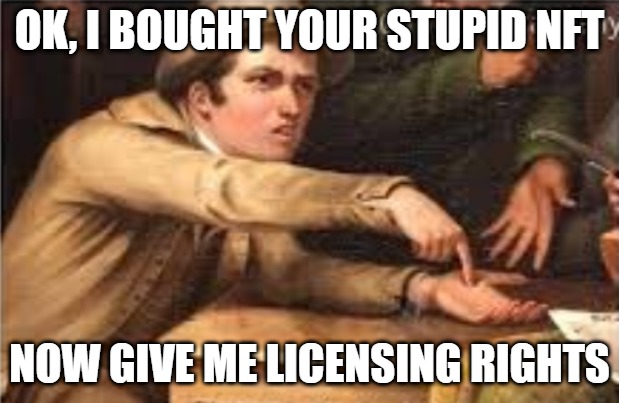
NFT Investing Strategy #3: Invest in NFTs with Income Streams
If you buy an NFT without licensing rights, you’re giving up so many ways to make money on it in the future. Demand that NFT sellers offer it under the NFT License 2.0, which lets you earn up to $100,000 per year in licensing fees.
If you buy a CryptoPunk, you should be able to plaster that mofo on T-shirts, mouse pads, and toaster cozies. You should be able to pitch a new series to Netflix based on your NFT, because you own it. That CryptoPunk should work for you: otherwise, you’re the punk.
If you buy an NBA Top Shot, you should be able to get royalties on that clip every time it is broadcast anywhere in the world, in perpetuity.
Instead, here’s the common licensing terms that most people agree to when buying an NFT:
“Your purchase of [the NFT] does not give you the right to publicly display, perform, distribute, sell or otherwise reproduce [the NFT] for any commercial purpose.”
How does this make sense?
As a long-term value investor, I am very excited about the possibility of NFTs that would earn revenue over the long term. I would totally buy an NFT of a pop song that would pay me royalties on every stream, or an NFT of a book that pays royalties on every copy sold.
Dapper Labs, the OGs of the NFTs, actually released an NFT License 2.0, which does exactly that: it offers the ability to commercialize your NFTs – to make money with them. With this license…
…you can do with your Kitty art what you could never do with Mickey Mouse: you can take the art and design associated with the NFT, and make a living by using that art in creative ways. Put it on a shirt. Make your own comic book, featuring your Kitty. Buy 52 Kitties, and put the art on a deck of playing cards. The possibilities are endless. (Full blog post here.)
This sounds pretty great: you can make up to $100,000 per year by licensing your NFT, if it’s offered under the NFT License 2.0.
The only problem? NFT License 2.0 was released years ago, and no one’s using it.
That’s because NFT “investors” do not know any better. They think this is as good as it’s going to get. I will always side with the investors, so I am encouraging all you Bored Apes and Stoner Cats and Meth-Huffing Coyotes to demand the NFT License 2.0.
DEMAND LICENSING AND ROYALTIES ON YOUR NFTs.
The Future of NFT Investing: The Bowie Bond
While most individual NFTs are a waste of your hard-earned money, NFTs as an asset class are potentially a revolutionary technology that will allow us to invest in innovative ways. Here’s an interesting example.
In my book Blockchain for Everyone, I tell the story of the Bowie Bond, which was a financial instrument launched by David Bowie in 1997 with the help of banker David Pullman. They offered a bond that earned income based on the future royalties of David Bowie’s music.
If you were a Bowie fan and looking for a reliable income stream, you could buy one of these bonds, which would pay you a percentage of Bowie’s ongoing royalties. In return for giving up these future royalties, Bowie got a bigger payday up front, which he used to invest in Internet businesses during the dot-com boom. (The full story is fascinating.)
In the future, we’ll see:
- Fractional Ownership NFTs: artists will create NFTs that will pay the holders direct royalties. For instance, an NFT could represent ownership of a music track, with a portion of streaming royalties distributed to token holders.
- Smart Contract Royalties: NFTs will be programmed with smart contracts that automatically distribute royalties to holders whenever the NFT is resold on a secondary marketplace. This provides an ongoing revenue stream to early investors in the work.
- NFT Renting: Like renting apartments or cars, you can lend your NFTs to other users, in exchange for a fee. For example, in play-to-earn (P2E) games, players might rent your in-game NFTs (weapons, avatars) to enhance their gameplay. See platforms like Axie Infinity’s Marketplace.
- NFT Staking: Some NFT projects offer staking opportunities. Here, you lock up your NFT for a predetermined period and earn rewards in the form of tokens or even additional NFTs. This incentivizes holding the NFT long-term, while potentially generating additional income.
- Yield Farming with NFTs: This strategy involves depositing your NFTs into liquidity pools on DeFi (Decentralized Finance) platforms. These pools provide liquidity for NFT marketplaces, and in return, you earn rewards in the form of tokens. (Note: extremely risky.)
As intelligent crypto investors, we look for underlying value. Most NFTs today have zero underlying value. But NFTs as a concept have a ton of potential value, especially if they are linked to things that really do have value (royalty streams, real estate, etc.).
For me, NFTs are currently a giant bubble made up of a million smaller bubbles. I’m not going anywhere near them. But I believe that bubbles are usually the “startup capital” needed to fund some great next stage of innovation. That next great wave of NFTs, I believe, may actually be quite nifty.
Related Articles:
- NFT Investing: How to Buy Sorare Trading Cards
- NFT Investing: How to Buy NBA Topshot Moments
- NFT Investing: How to Buy Hashmasks
- NFT Investing: How to Buy Cryptopunks

